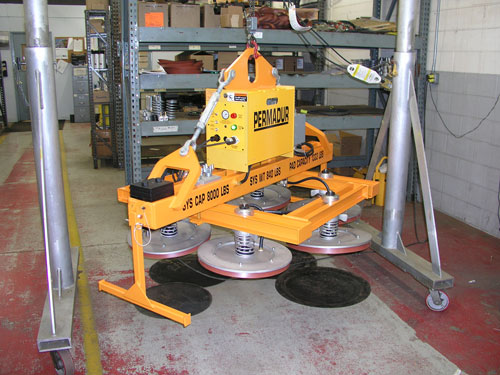Seal leaks halt production, frustrate staff, and strain budgets. One bad pad can stop an entire line while workers scramble for spares and managers juggle schedules. Each unplanned outage chips away at confidence in the lifting gear and invites questions about safety.
A solid, long-lasting seal is the heart of every vacuum lifter. When you match pad material to the job, follow a strict inspection plan, and use simple daily habits, seals last much longer. These clear steps line up with OSHA rules and ASME guidelines, cutting downtime and keeping lifts steady.
What causes seals to fail so fast?
Thin rubber rings face heat, grit, and sharp edges every shift. Four common stress points appear in nearly every plant.
- Abrasion from rough or dirty surfaces grinds rubber until it thins and splits.
- Chemical attack from oils or coolants softens certain compounds, leading to swelling and tears.
- Heat dries pads, making them brittle and prone to cracks.
- Permanent compression flattens the seal when heavy beams press down without relief.
Each factor works quietly until a pad leaks, often in the middle of a busy lift. Knowing these stresses lets you pick fixes that stop damage at its source. A close eye on these four areas prevents most early failures and keeps pads working longer.
Which seal materials match your workplace?
Every pad compound has strengths and weak points. Pick the wrong one, and the seal will fail well before its time.
- EPDM stands up to water, steam, and outdoor weather; avoid heavy fuel or oil contact.
- Nitrile handles oily metal parts and machining fluids; expect it to stiffen near freezing.
- Silicone keeps its grip in hot or cold zones; it nicks easily on rough steel edges.
- Polyurethane resists cuts on rough lumber or stone; it costs more and demands careful load checks.
Choosing the right material removes many chemical and heat problems before they begin. A short material review with your supplier often doubles seal life and saves hours of crane downtime. Matching pad to environment is the single quickest win in the fight against leaks.
How often should you inspect and replace seals?
Regular checks catch small cuts before they turn into lost loads. A schedule that works in most shops looks like this:
- Wipe each pad at the start of every shift and look for cracks or loose edges.
- Run a simple two-minute hold test once a week and log the vacuum level.
- Change any pad with a cut deeper than two millimeters or a flattened ridge that will not spring back.
- Swap or rotate seals at least every six months; quicker if the weekly test shows slip.
Keeping a paper or digital log shows patterns, proves compliance, and guides the next cycle. A firm timetable removes the guesswork and keeps maintenance calm instead of chaotic.
Daily habits that protect every seal
Small habits make a big difference.
- Clean chips, dust, and weld spatter from each plate before the pad touches it.
- Lower the lifter slowly; avoid scraping thin edges and corners.
- Store spare pads flat in a cool, shaded place, away from electric motor sparks and ozone.
- Train crews to report even mild slips so you can trace the cause at once.
These steps cost little time, yet guard seals from hidden cuts and chemical damage. A tidy surface and gentle contact add weeks of use to every pad.
Why keeping downtime records pays off
An hour lost to a leaking pad can cost more in labor and crane time than a full box of new seals. Tracking each leak, change, and test highlights trouble spots and justifies better pad materials or more frequent checks. Clear numbers turn guesswork into fact, making it easier to plan budgets and improvements.
Keep seals tight and production moving
Seal leaks do not have to rule your calendar. Match pad material to real shop conditions, stick to a strict inspection schedule, and follow clean handling habits. Crews see fewer slips, managers see fewer delays, and safety inspectors find a well-run lifting line. Review your current seal compound and maintenance plan today, then talk with a trusted vacuum-lifter supplier about a schedule that keeps every pad working longer.


